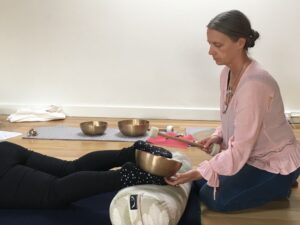Sound therapy is first and foremost a holistic method of relaxation. It could also become other means of expression in the hands of a professional where it can be used directly and effectively in the fields of education, counselling, therapy and medicine.
Sound therapy always aims to strengthen the health and wellbeing (see the Antonovsky’s salutogenic model). The strong solution and resources focus of these methods turn attention to the whole person with all her skills and knowledge (resources) – even if in some situations these resources are not accessible. Tempo, intensity and direction of sessions are always in coordination with the needs of clients – they know best (deep inside), what is good for them (see image of man in humanistic psychology).
Simplicity and mindfulness

Sound massage
It’s less about a goal-oriented action, and more about the careful and loving companionship of a client / patient on her/his path of personal development, growth or healing.
From the latest research, we know how important our mental images and our intentions are for the effect of an action. Therefore, in our education we place particularly great value on:
- transfer of substantial background knowledge of the effects of the sound,
- training of our own response capability (based on the personal and group experience with sound) and
- practice the awareness of one’s intention.
For us, the expansion of professional skills of our students, is as important as learning the method to enrich their own life with sound.


Leave a Reply